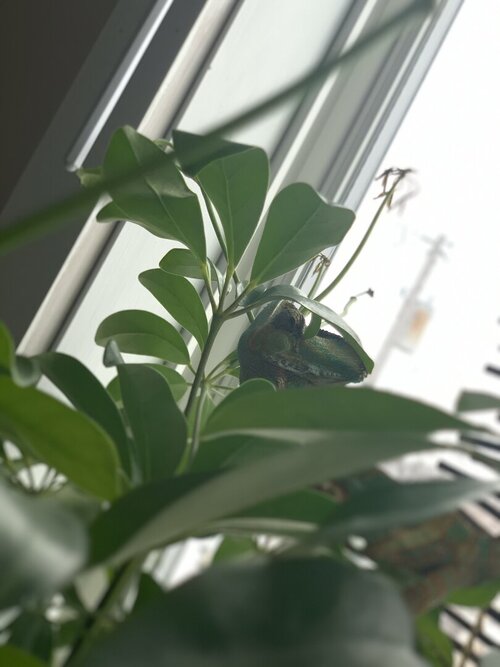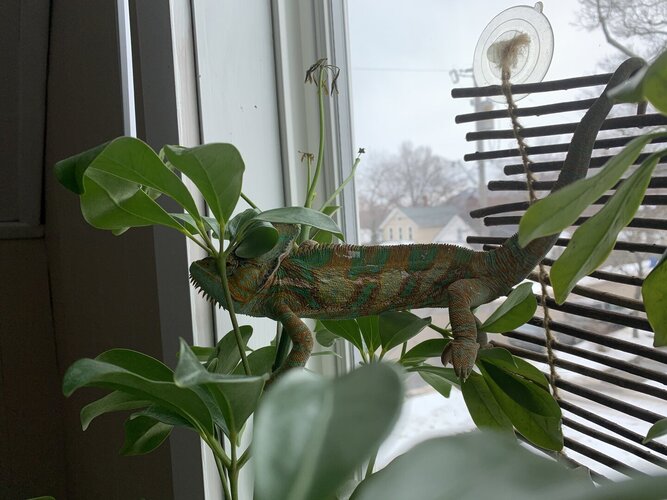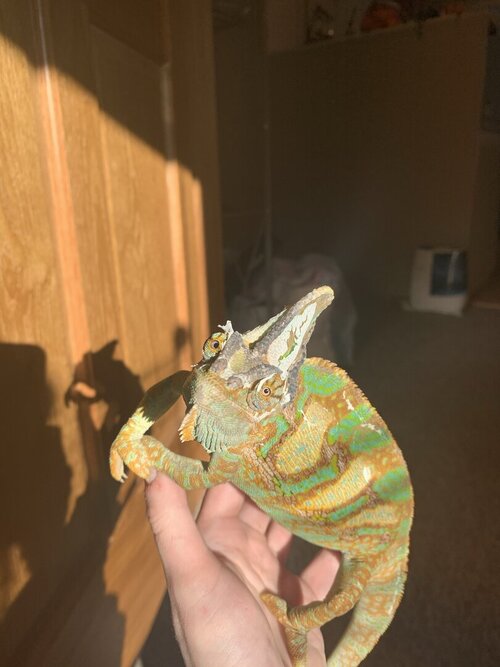mbist
Member
Updated husbandry check
- Your Chameleon - The species, sex, and age of your chameleon. How long has it been in your care?: I have a male veiled chameleon who is about 2 years old. He has been in my care since he was about 3-4 months.
- Handling - How often do you handle your chameleon?: When he was younger he would come out frequently, pretty much everyday, but now I only take him out 2-3 times a week.
- Feeding - What are you feeding your cham? What amount? What is the schedule? How are you gut-loading your feeders?: I feed him crickets gut loaded with fresh vegetables (kale, collards, squash, carrots, bell peppers, ect) He gets 2-3 crickets every 3 days. I put him on a diet a month ago because his fat pads on his face and the rear of his casque were getting plump.
- Supplements - What brand and type of calcium and vitamin products are you dusting your feeders with and what is the schedule?: I’ve been using a variety of supplements... Arcadia Earth Pro-A, Repti calcium, Rep-Cal calcium w/ d3, and Rep-Cal herptivite multivitamin. My supplement schedule - Week 1: Calcium w/o d3 Mon-Sat and Calcium w/ d3 on Sun Week 2: Earth-Pro A Mon-Sat and Multivitamin on Sun - Repeat
- Watering - What kind of watering technique do you use? How often and how long to you mist? Do you see your chameleon drinking?: His dripper is on for 2-3 hours everyday and I do catch glimpses of him drinking often. I try not to disturb him much when his dripper is on, I’ll just distract him from drinking if I watch. I don’t mist much during the day, but I do later in the evening and at night before bed.
- Fecal Description - Briefly note colors and consistency from recent droppings. Has this chameleon ever been tested for parasites?: Normally his fecal matter is brown, firm but slightly slimy; I’ve never been concerned. His urate has been white, slightly yellow, also normal. Until yesterday, he had a very strange urate which is what my last post was regarding. Thread 'Sudden change in urate' I was hoping this updated husbandry check could give more insight on that issue.
- History - Any previous information about your cham that might be useful to others when trying to help you: The first month of owning him I was incorrectly supplementing. I was putting the supplement powder on the insects way too soon, and by the time Raymond ate them the supplement would nearly be gone. This unfortunately led to the start of MBD. One day, I noticed his front arms were injured, I thought maybe even fractured. It appeared to me that he had fallen while sleeping. I took him to a vet who claimed to be familiar with reptiles, but offered no help with Raymond other than an antibiotic. My hyper chameleon mom mode really went into gear after this and I spent, and still do spend, a lot of time researching and figuring out what I did wrong. I started to add the supplement right before Raymond ate, I started cup feeding to regulate exactly what he was eating, and I made sure the supplements were fulfilling his needs. It didn’t seem to get worse, his mobility is still good and his grip is strong. But still, I feel horrible I let it happen and it really taught me how hands on and aware you have to be with your chameleon. Just a couple months ago I noticed the top of his casque had a small burn, so I adjusted his basking light and added some neosporin. It healed a bit and it definitely isn’t getting worse.
- Cage Info:
- Cage Type - Zoo Med Reptibreeze screen cage, 2x2x4
- Lighting - What brand, model, and types of lighting are you using? What is your daily lighting schedule?: 12 hours on, 12 hours off. 75w basking bulb, I think the one I’m using now is Zilla. T5HO Arcadia 6% for UVB. The basking light and UVB are both 8” away from nearest branch.
- Temperature - What temp range have you created (cage floor to basking spot)? Lowest overnight temp? Ambient temp is usually at 72-75 and the basking temp is in the low 80’s. Overnight temps are 65-70.
- Humidity - What are your humidity levels? How are you creating and maintaining these levels? What do you use to measure humidity?: Humidity during the day is at 40% and at night about 75%-80%. During the day the live plant and dripper provide enough humidity, but during the night it’s more difficult to maintain a high humidity. I have a Levoit humidifier that is pretty nice but I’m looking into getting a fogger.
- Plants - Are you using live plants? If so, what kind?: I have a large benjamina ficus in the middle of his enclosure, but I do have some fake plants along the screen sides and going along the branches I added. I have never seen Raymond try to eat any of the plants in his enclosure. I want to add more live plants, but I can’t figure out how to mount them to the screen without damaging it. I’m in the process of designing a new enclosure that I’m going to build this summer. It’ll be able to support live plants so I can get rid of the fake ones.
- Placement - Where is your cage located? Is it near any fans, air vents, or high traffic areas?: At what height is the top of the cage relative to your room floor?: His cage is in my room on a plastic shelf I got from Menard’s. It’s not a high traffic area and it has good air flow, but there’s not a vent directly by him. His enclosure is lifted about 3 ft so he sits about a foot above my head.
- Location - Where are you geographically located?: Minnesota, USA



